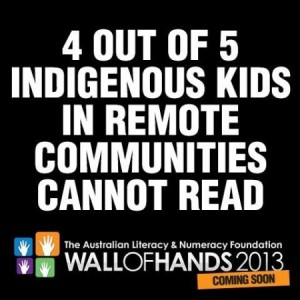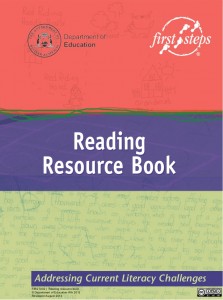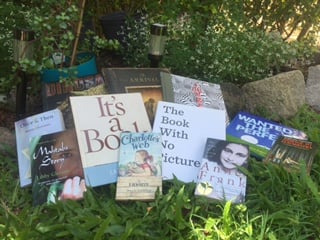One is seven 15 year olds doesn’t have basic reading skills. I was watching television the other night and this frightening statistic appeared on the following advertisement.
 4 out of 5 indigenous kids in remote communities cannot read! Recently, Lyn Sharratt, the well-renowned co-author of Putting Faces on the Data, was working with a number of Metropolitan schools in Queensland and she used a photo she had taken of a bus shelter that displayed data similar to this statistic. Regardless of age or background, Lyn repeatedly expressed the sense of urgency needed around the teaching of reading.
4 out of 5 indigenous kids in remote communities cannot read! Recently, Lyn Sharratt, the well-renowned co-author of Putting Faces on the Data, was working with a number of Metropolitan schools in Queensland and she used a photo she had taken of a bus shelter that displayed data similar to this statistic. Regardless of age or background, Lyn repeatedly expressed the sense of urgency needed around the teaching of reading.
This is a continuing major focus for many schools in Metropolitan Queensland, so hence my quest to research as much as I can on the teaching of reading during this Easter break.
There are many schools of thought around the teaching of reading but I think all would agree that it requires a balanced approach. I have begun my personal reading on this topic with the First Steps in Reading (FSiR) Resource Book, because of its contemporary research and developments in the field of literacy (pp 5-6). The authors of FSiR state that the ultimate aim of any reading program is to produce confident, competent and independent readers (p5).
I have begun my personal reading on this topic with the First Steps in Reading (FSiR) Resource Book, because of its contemporary research and developments in the field of literacy (pp 5-6). The authors of FSiR state that the ultimate aim of any reading program is to produce confident, competent and independent readers (p5).
They state that a strong foundation for a comprehensive reading program can be established when a range of reading procedures are strategically employed and where the following seven procedures have been identified:
- Reading to students
- Modelled reading
- Language experience
- Shared reading
- Guided reading
- Book discussion groups
- Independent reading
These seven procedures fit nicely within the Gradual release of responsibility model (if you haven’t heard of this model, Doug Fisher has written an easy-to-read article on its application).
The first three procedures: Reading to students, Modelled reading and Language experience allow the teacher to demonstrate strategies which will assist students to make sense of text (I do it). NB: I will argue that the third, Language experience fits more within the We do it step.
Language experience, Shared and Guided reading give opportunities for students to practice these strategies with guidance and support (We do it).
Book discussion groups allow students to apply what they have learnt about reading with their peers (You do it together) and Independent reading sessions allow students to apply this knowledge on their own (You do it alone).
My next few blog posts will focus on the teaching of reading using the seven procedures in each of the stages of the Gradual release model. Looking forward to exploring these over the coming days.
